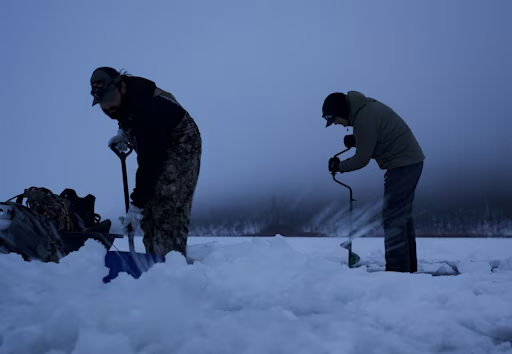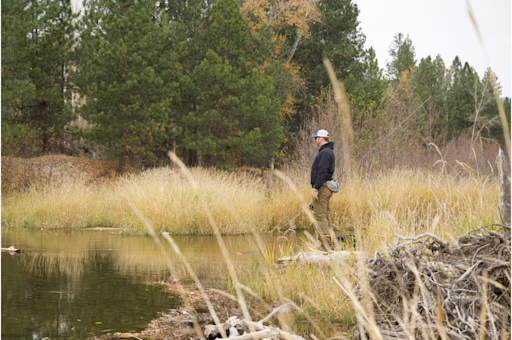Mental health benefits of fishing
We love fishing, but it turns out fishing can love us back. During the winter months when the sky is gray and the thermometer won't get above 30, serious mental health problems can arise. Check out how our favorite past time can help with our struggles this time of year and why it is worth it to hit the water during the coldest time of year.
Share this article

When January first arrives along Montana’s Bitterroot River, a seemingly endless supply of sun-blocking clouds arrive with it. Cold weather and dark skies fill the month, relegating the sun and warmth to your memory.
Seasonal affective disorder (SAD) is a form of depression that can be caused by ongoing mental health issues, a lack of vitamin D from a lack of sunlight, a lack of outdoor activity and more. Seasonal affective disorder is a real issue for people all over the Northern Hemisphere and can be a difficult disorder to combat. Cabin fever, with a deficiency in vitamin D from the lack of sunlight can be powerful forces on the human psyche and one of the best cures for it all is fishing. We have covered some of the physical health benefits fishing offers, but the mental benefits can be far more important.
Fishing is not always the first activity people pursue during the months where seasonal depression is at its highest, but it may be the most important time to get out.
According to the Mayo Clinic, some of the signs indicating a seasonal affective disorder are:
Sadness
Anxiety
Extreme fatigue
Weight gain
Inability to concentrate
Irritability
Loss of interest in usual activities (even fishing)
And more
Strategies for combating seasonal affective disorder
Phototherapy (using direct indoor lighting to stimulate vitamin D production)
Spending time outdoors
Vitamin D
Antidepressant medication
How fishing can help your mental health

It's important to note that seasonal affective disorder can have serious consequences with someone experiencing other forms of depression and mental health issues. Anyone experiencing a history of mental health issues, who is also feeling the effects of seasonal affective disorder should absolutely contact their doctor, or mental health professional.
According to the National Alliance on Mental Illness, even if you are not suffering from a clinically diagnosed case of seasonal affective disorder, going out and partaking in one of your favorite hobbies can do wonders for your mental health during a down time of year.
Three recommended treatments for seasonal affective disorder are getting more sunlight, taking vitamin D and outdoor activities. All of these treatments can be accomplished by forcing yourself out the door and going fishing.
The fresh air and natural light you will soak in from being out on your favorite body of water for a few hours is a wonderful way to get vitamin D into your body. Even if the day is cloudy (which it usually is) the natural light seeping through the clouds is still better than artificial light.
Meditation is another recommended form of treatment and most anglers would agree that spending time near a body of water with a concentrated goal of catching a fish is a deep form of meditation.

Exercise is another great treatment for seasonal affective disorder as it helps reduce stress and anxiety, according to Baylor College of Medicine. Fishing is sneakily a fantastic form of exercise, if you are constantly moving to new holes and casting into different waters. Several hours of fishing can result in several miles of travel, keeping you focused on where you are and what you are doing. This focus can help you break through the brain fog and trouble concentrating often associated with seasonal affective disorder.
Water is also proven to provide more quality air and the trees and bushes inevitably near your water source will also help provide a more clean and rich oxygen environment. The increase in this fresh oxygen will do wonders for your ability to focus and think clearer than you have in months.
A sense of accomplishment

Fishing in winter is often one of the hardest times to land a fish. The cold weather and lack of readily available food cause a fish's metabolism to slow way down. This makes fish sluggish and less likely to swim out of their way to run down your bait. Anglers often need to change their tactics completely to slow moving retrieves with soft plastic baits for bass anglers, or dead drifting nymphs for fly anglers.
When you hook up on a fish this time of year, it's usually because you knew what you were doing and you used the right tactics. When you hold a fish in your numb hands, it gives you a sense of accomplishment that can cut through all the gray skies and cold weather you’ve been dealing with.
Winter can be a tough time for all of us, but a snow covered bank and frosted guides can offer the clarity we all need at times. We encourage everyone to experience the beauty of winter and to find a form of salvation offered in this harsh, yet beautiful time of year.
Now let’s go fishing.
If you havent experienced the #1 fishing app worldwide, make sure and check out Fishbrain to see all the fish data, fishing spots, weather conditions you've been missing out on plus much more. Note: fishing is not a form of treatment for depression, nor is it a substitute for any medicine prescribed by a doctor. Its effects can help you navigate through periods of depression, but it's important to also seek professional help. This world needs more anglers in it and not one less.

Download the Fishbrain app and access the best fishing spots in your area
Related blog posts
Master the hardwater season with advanced ice fishing tips . Learn how to find fish faster, refine your search and adjust presentations to catch more fish all winter long.

Your guide to Victoria’s best fish to catch in rivers, lakes, and coastal waters. Learn prime species, fishing tips, and key regulations

Learn how fish adapt as water temperatures cool from autumn to winter, including changes in behavior, metabolism, and habitat that help them survive.




